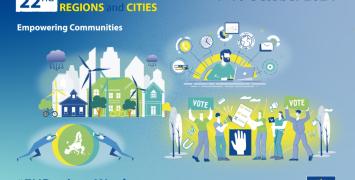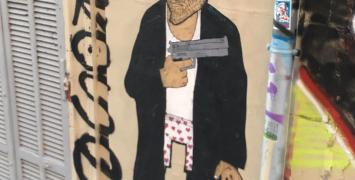Street science

By Eilish Brault
Why did you choose to research hip hop?
‘I am a hip hop fan and scholar. It is really satisfying to show exactly how complex, nuanced, and artistic this culture is.
My first book was on European hip hop and how artists from diverse backgrounds use African American arts as protest strategies. That book, Flip the Script, centred on Turkish Berliners, Senegalese Parisians, and South Asian Londoners. It is about the colonial histories that people in Europe recall when they hear the African American experience encoded in this music.
I wanted to explore why this iconically African American music is so well loved—and so much appropriated—around the world. I had the idea to bring in a computational side and look at how ideas are translated to suit local situations: can we map and see how ideas spread in this music? And at a broader level: is hip hop a place where we can try to understand how culture works?'
How did you put together your team?
‘We had a diverse team of regional experts: an Africanist, an Asianist, a Latin Americanist, and I was the Europeanist and North Americanist. The ethnographic fieldwork only fully commenced after COVID. For instance, our Latin Americanist, Gustavo Souza Marques, travelled to five different countries: his home country of Brazil, as well as Colombia, Jamaica, Mexico, and the US.
On the data analytics side, we faced four unsuccessful searches during COVID and its aftermath. This was due to various reasons, including the challenges in matching pay scales between universities and the tech industry. Eventually, a data scientist from Bangalore, Shyam LB, joined us in May 2023. He did an exceptional job helping us create a beta version of our new global hip hop research engine, 3rdAI, which is now online.
Initially, my PhD student was intended to reflect my work across Europe and North America. However, the best application we received for the PhD position came from Ophelia McCabe, an artist and MC. She proposed to do freestyle ciphers, where rappers improvise lyrics, to transform that into an arts practice research space. This approach examines how ideas flow, connect, and inspire in real time. Ophelia would introduce a concept for everyone to riff off in the cipher, and the outcomes would form the basis of her research. This is a totally new research methodology. The ERC allowed us to incorporate this arts-based research component alongside the ethnographic and computational aspects of the project. Having an artist as a researcher really was a wonderful addition to the project.’
What does the acronym CIPHER refer to?
‘CIPHER represents the circle of knowledge and artistic production. In hip hop, a cipher is also a gathering where MCs hone their skills and sharpen their blades in lyrical combat.
Research doesn’t just happen in universities; it takes place in the streets through art. This concept is central to CIPHER’s name and underlying theory. Hip hop culture possesses its own invaluable knowledge, connecting us to pre-modern forms of knowledge transmission and performance.
While hip hop is a multi-billion-Euro industry, that is only part of the story. The world’s most popular music genre emerged from the streets, from the gutters, from the voices of the least, the last, and the lost. This final conference, which took place in May 2024, celebrated those origins and aimed to increase recognition of street knowledge in academic spaces, hoping to open up funding for projects beyond high art or official politics. The conference title, Droppin’ Science – a classic hip hop phrase – sends a clear message: hip hop is a science too.’
What finding surprised you the most?
‘In our methodology we talk about hip hop gems – highly intertextual lyrics, samples, and references that artists use worldwide. For instance, I noticed that French artists often adopt and localise the same cultural references and terminologies African American rappers use. Take the hip hop discourse around the third eye, which serves as shorthand for media literacy, second sight, consciousness, whatever you want to call it. The third eye is, of course, an ancient South Asian idea of seeing more deeply. Yet, if you look at its history in hip hop discourse, it pops up in places like Marseilles in the early 90s, then the UK, and later East Asia, each adapting this gem of enlightenment or consciousness in their own way.
One of my significant studies was a trip to Italy to understand how Italian artists place hip hop knowledge in their own context. I initially expected to find references to Roman figures like Nero, Caesar, or centurions in the lyrics. Instead, I came across something more anti-establishment and decolonial. Through our gem-based approach, one particularly anti-colonial figure stood out: Annibale (Hannibal). References to Annibale, Elefanti, Alpi, and Carthagine (Carthage, Elephants, Hannibal crossing the Alps) kept coming up. Of course, the Roman Empire wouldn’t be a focus for these hip hop artists! Instead, they are drawn to the badass who defied the Empire by leading elephants over the Alps.
One track that I really loved was 'Annibale' by Bakis Beks, a Sardinian rapper. He uses the expression elephant in the room to explore how people avoid discussing issues like race, migration, or the rise of the far right in Italy. And he says, 'I'm going to drive that elephant in the room right over the Alps and into popular discourse in Italy!'
Through this fieldwork – listening, engaging, and analysing – I found my theory reinforced: hip hop is a counter-hegemonic art form. The act of working through ideas and politics musically is revolutionary. Western life has often depoliticised the arts, but hip hop reminds us that the written word tells only part of the story.’
Are you satisfied with the project’s outcomes?
‘We have confirmed our thesis that hip hop spreads globally due to gems of knowledge that resonate across cultures, drawing people into hip hop’s unique ways of understanding the world. One surprise, however, was realizing that it’s not only conceptual knowledge but also felt knowledge that enables hip hop to glocalise—what the British cultural theorist Paul Gilroy describes as a shared identity of passions.
One of our most significant outputs has been the creation of an entirely new journal, called Global Hip Hop Studies. Additionally, we co-authored an article in Ethnomusicology that explores hip hop 'gems' across diverse global contexts, laying much of the groundwork for this project. I am currently a visiting scholar at Columbia University, where I am expanding the ERC research into a book-length project titled, Hip Hop Interpellation, and an open access hip hop textbook titled, Planet Rap.
Looking ahead, I am eager to explore how music influences subjectivity in a future project – examining how rhyme feels almost evolutionarily ingrained in us. Just as the ancient griots of West Africa or the Celtic seanchaí and bards used rhyme and meter to captivate and connect audiences, rhymed connections help us remember stories and spark new associations. Our work has only begun to scratch the surface of hip hop’s transformative power across cultures – there is much more to discover.’
Biography
J. Griffith Rollefson is Professor of Music at University College Cork. He is the author of two books, Flip the Script: European Hip Hop and the Politics of Postcoloniality (University of Chicago Press, 2017) and Critical Excess: Watch the Throne and the New Gilded Age (University of Michigan Press, 2021). Rollefson is founding co-editor the community-engaged open access journal Global Hip Hop Studies and from 2019 to 2024 led the ERC research initiative CIPHER: Hip Hop Interpellation. He is currently Visiting Scholar at Columbia University where he is working on a textbook and a volume based on the ERC research.






